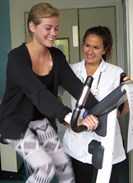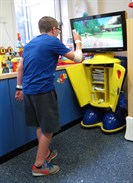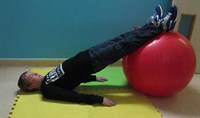 A paediatric physiotherapist is there to support your child depending on their specific needs: airway clearance, inhalation therapy, exercise, or in rehabilitation following surgery or a stay on PICU.
A paediatric physiotherapist is there to support your child depending on their specific needs: airway clearance, inhalation therapy, exercise, or in rehabilitation following surgery or a stay on PICU.
We will see your child as an inpatient, and in the outpatient clinic, and we have homecare services for children with certain medical conditions.
The team
The specialist paediatric physiotherapy team is an award-winning service delivering an exceptionally high level of patient care to children with respiratory and cardiac disorders. 
A team of 11 physios will review and support your child if they have a chest issue as well as chronic conditions such as PCD and CF. They will assist your child on HDU and PICU if they have cardiac issues, a neuromuscular disorder or respiratory disorder, to help move phlegm off their chest.
Our extended team also provide support in the home for NIV and outreach for CF, PCD, long-term ventilation and neuromuscular patients.
The physios work closely with the extended paediatric rehabilitation and therapies teams.
Exercise and posture for respiratory patients
 Because patients with long-term respiratory conditions can be at risk of postural changes with frequent coughing and shortness of breath, it is important to ensure that your child has an active lifestyle.
Because patients with long-term respiratory conditions can be at risk of postural changes with frequent coughing and shortness of breath, it is important to ensure that your child has an active lifestyle.
Regular exercise is strongly encouraged, not only to promote general health and wellbeing, but also to assist with airway clearance and hopefully improve/maintain your lung function. Exercise should be fun and enjoyable and be of an intensity to get you out of breath, a bit sweaty and elevate your heart rate.
If you’re unsure what exercises to do ask your physiotherapist for advice.
Physiotherapy on HDU/PICU
During your child’s stay in hospital, they may be referred for physiotherapy. The length and frequency of treatment will vary from child to child and will depend on their individual needs.
If your child is on a ventilator
When children are on a ventilator, they may have increased lung secretions (mucus or phlegm). Whilst they have a breathing tube in place, they cannot cough to clear this mucus themselves, so will need nursing staff or the physiotherapist to use suction to remove it. This involves passing a small catheter down the breathing tube to suck out the excess fluid.
Other techniques such as "bagging" (using a small bag to help your child take deep breaths), “shaking” (gently shaking your child’s chest to move secretions) and positioning, may also be used to aid clearance of sticky secretions and to improve lung expansion.
The physios may also recommend inhaled medications to reduce wheeze or to help clear particularly sticky secretions before chest physiotherapy sessions.
Physiotherapy techniques can sometimes look upsetting and uncomfortable, but any pain is well managed during sessions and children will often settle more quickly after treatment, as their breathing is then more comfortable.
When your child is off the ventilator
Once your child is able to breathe for themselves and they are taken off the ventilator, they may still have increased lung secretions for a short time.
Physiotherapy techniques such as “percussion” (rhythmical patting on your child’s chest) can be used to loosen secretions, then either the child coughs them out or swallows the secretions. Or suctioning may still be required, this time via the nose.
Sometimes children require some extra support with their breathing after the breathing tube is removed. This can be provided by face mask or nasal mask (non-invasive ventilation), a jacket around their chest (cuirass) or infant nasal prongs (flow driver CPAP). This helps to reduce the effort of breathing and hold airways open as they get stronger.
Exercise and walking
Exercise is also a useful treatment technique. When appropriate we will encourage your child to come out for cuddles / sit out in a chair or start walking (if age appropriate). If the patient has been on the PICU for a long time, they may require more intensive rehabilitation to help them get strong again and then aim towards their developmental milestones.
When appropriate, we will also refer you to your local community rehabilitation services for continued rehabilitation. Physiotherapists and nursing staff will advise you on how to handle your child as they may still have lines attached and how to avoid strain on incision sites.
Sternotomy advice
In some heart operations surgeons must cut through your child's chest bone (sternum). After this they sew it back together and put a plaster on top.
In other heart and lung surgeries the cut is made at the side of the chest between the ribs. After these operations, you must take certain precautions, which your physiotherapist will explain to you.
Questions?
If you have any questions or would like further advice about physiotherapy techniques, please ask to speak to a physiotherapist.
